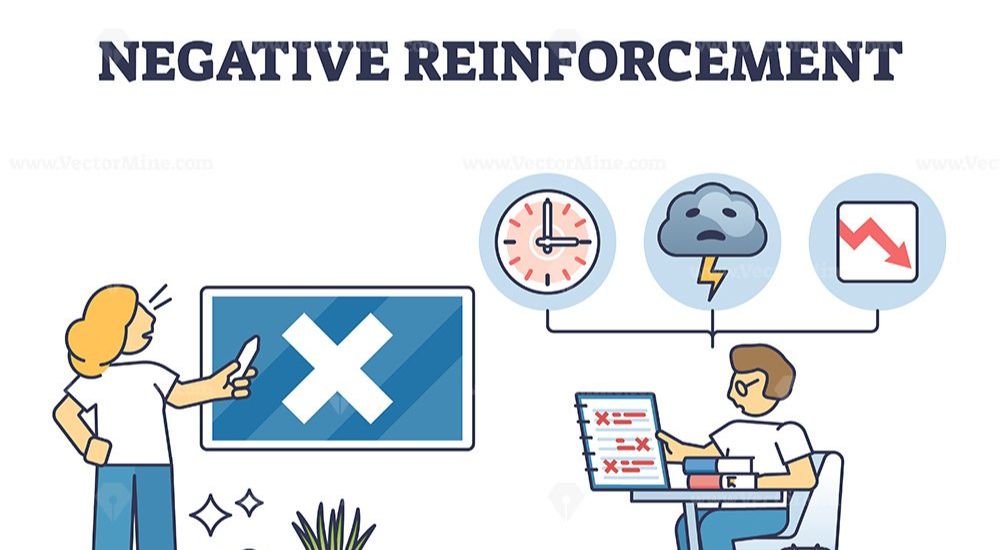Negative Reinforcement – Understanding the Psychology Behind It

In everyday life, we constantly learn and adapt based on the consequences of our actions. This learning process is at the heart of behavioural psychology, and one of its key concepts is negative reinforcement. While the term may sound like something unpleasant, negative reinforcement is not about punishment—it’s about removing an unwanted stimulus to encourage a desired behaviour.
In this blog, we’ll explore what negative reinforcement is, how it works, examples from daily life, its difference from punishment, and why understanding it can help in parenting, education, workplace management, and even personal growth.
What Is Negative Reinforcement?
Negative reinforcement is a concept from B.F. Skinner’s Operant Conditioning Theory. In this context:
- Negative means “removal” or “taking away” something.
- Reinforcement means “increasing the likelihood of a behavior.”
So, negative reinforcement happens when a behavior strengthens because it helps remove, reduce, or avoid something unpleasant.
Simple Example:
You fasten your seatbelt, and the annoying seatbelt alarm stops. The removal of the irritating sound increases your likelihood of wearing the seatbelt in the future.
Negative Reinforcement vs. Punishment
People often confuse negative reinforcement with punishment.
| Aspect | Negative Reinforcement | Punishment |
|---|---|---|
| Purpose | To increase a behaviour | To decrease a behaviour |
| Method | Remove an unpleasant stimulus | Add an unpleasant stimulus (positive punishment) or remove a pleasant stimulus (negative punishment) |
| Example | Doing homework to avoid teacher’s scolding | Teacher scolds for not doing homework |
In short: Negative reinforcement strengthens behaviour, while punishment weakens it.
Real-Life Examples of Negative Reinforcement
1. Parenting
- A child cleans their room to avoid their parent’s nagging.
- A teenager studies harder to avoid losing weekend privileges.
2. Education
- Students complete assignments on time to avoid extra homework.
- Teachers may stop giving surprise tests when class participation improves.
3. Workplace
- Employees meet deadlines to avoid last-minute stress from supervisors.
- A worker wears safety gear to avoid repeated safety warnings.
4. Health & Fitness
- Exercising regularly to avoid joint pain.
- Eating a healthy diet to avoid acid reflux symptoms.
5. Personal Life
- Leaving early for work to avoid traffic jams.
- Paying bills on time to avoid late fees.
The Science Behind Negative Reinforcement
Negative reinforcement works because of a feedback loop in the brain involving:
- Operant Conditioning: Learning through consequences.
- Dopamine System: Relief from removing discomfort releases dopamine, reinforcing the behavior.
- Avoidance Learning: The brain remembers what action helped avoid discomfort, making it more likely to repeat it.
Over time, if the unpleasant stimulus is consistently removed, the behavior becomes a habit.
Potential Downsides
While negative reinforcement can be effective, it has drawbacks if overused:
- Avoidance Patterns: People may focus on avoiding discomfort rather than seeking growth.
- Stress and Anxiety: If the aversive stimulus is too intense or frequent, it can create chronic stress.
- Dependency: The desired behavior may vanish if the unpleasant stimulus is no longer present.
Using Negative Reinforcement Positively
To use negative reinforcement effectively:
- Pair It with Positive Reinforcement – Reward good behavior, don’t just remove bad conditions.
- Keep the Aversive Stimulus Mild – Too much discomfort can harm motivation.
- Be Clear and Consistent – Make it clear what action will remove the negative stimulus.
- Focus on Growth – Gradually shift from avoidance-based learning to intrinsic motivation.
Negative reinforcement is not about punishment—it’s a powerful psychological tool for shaping behavior by removing an unpleasant experience. When applied thoughtfully, it can be useful in classrooms, homes, workplaces, and personal life. But like any behavioral strategy, it works best when balanced with positive reinforcement and when the goal is to encourage long-term healthy habits, not just short-term compliance.




